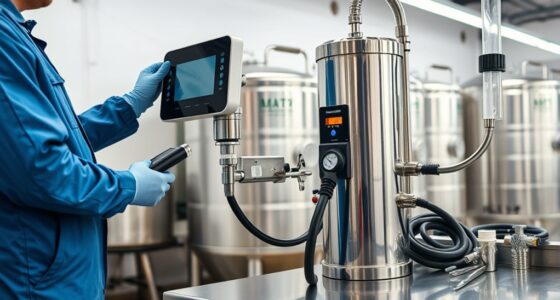To recover well from a C-section, start with gentle movements, gradually reintroducing activity like walking to boost circulation. Care for your scar by keeping it clean, applying silicone gels, and avoiding sun exposure, while massaging gently to improve elasticity. Build a support system for emotional strength and practice patience, knowing that holistic care promotes healing. Keep exploring tips to ease your recovery journey and ensure a smooth, comfortable healing process.
Key Takeaways
- Gradually resume gentle movements and light activities like walking to support mobility and recovery.
- Keep the scar clean, moisturized, and protected from sun exposure; use silicone gels for optimal healing.
- Create a soothing environment with proper lighting and air quality to promote physical and emotional healing.
- Seek support from family, friends, or support groups to enhance emotional well-being during recovery.
- Prioritize self-care and mental health practices alongside physical healing for a holistic recovery process.
Gentle Movements and Gradual Activity Resumption

After your C-section, it’s important to begin with gentle movements and gradually increase your activity level. Start with simple postpartum exercises that focus on gentle stretching to help your body adjust. These movements can include slow, controlled stretches for your legs, arms, and back, which improve circulation and reduce stiffness. Avoid any strenuous activities or heavy lifting until your doctor clears you. Listen to your body and don’t push too hard too soon. Gentle stretching can also help prevent tightness and promote flexibility as your body heals. As you feel more comfortable, you can slowly incorporate light activities like walking. Remember, patience is key—your recovery will be smoother if you ease into activity with care and attention. Contrast ratio plays a role in ensuring your environment is conducive to a comfortable recovery space, especially in dimly lit areas.
Effective Scar Management and Skin Care Strategies

Managing your C-section scar and skin carefully can considerably improve healing and reduce the risk of complications. To promote scar prevention, keep the area clean and avoid unnecessary tension or friction. Applying silicone gels or sheets can help minimize scar formation and improve appearance over time. Prioritize maintaining skin hydration by using gentle, fragrance-free moisturizers to keep the skin supple and promote healing. Avoid excessive sun exposure, which can darken scars and slow healing. Regularly massaging the scar with a soft, circular motion can improve circulation and reduce stiffness. Incorporating HEPA filtration in your environment can help reduce airborne irritants that might affect skin healing, especially if you have allergies or sensitivities. Remember, patience is key; consistent care supports ideal healing, reduces scar visibility, and helps you regain confidence in your skin’s appearance.
Building Your Support System and Emotional Well-being

Building a strong support system is essential for your emotional well-being during recovery. Surround yourself with family, friends, or support groups who understand what you’re going through. Prioritize postpartum nutrition to fuel your healing and boost your energy levels, which can positively impact your mood. Don’t hesitate to seek mental health support if you feel overwhelmed or anxious—talking openly helps you process emotions and reduces stress. Accept help with daily tasks so you can focus on resting and caring for your baby. Remember, recovery isn’t just physical; emotional resilience matters too. Incorporating self-care routines such as gentle eye patches can also promote relaxation and rejuvenation. Building a reliable support network and understanding the importance of privacy policies can create a safe space for your feelings, ensuring you feel understood and cared for as you heal. Additionally, engaging in emotional resilience practices can strengthen your mental health during this recovery phase.
Frequently Asked Questions
When Can I Start Driving After a C-Section?
You can usually start driving when you feel comfortable and have enough strength, typically around 2 to 4 weeks after your C-section. Make sure you’re not taking strong pain medications that could impair your ability to react quickly. Focus on your postpartum diet to support healing and stay hydrated, which helps with recovery. Also, continue breastfeeding tips to keep your energy up, but avoid heavy lifting or sudden movements while driving.
Are There Specific Exercises to Prevent Scar Adhesion?
Sure, because nothing says “fun” like obsessively preventing scar adhesions, right? To dodge scar tissue and adhesion issues, you can do gentle exercises like abdominal massages, light stretching, and controlled breathing. These help improve circulation and keep tissues from sticking. Just remember, always consult your healthcare provider before starting any routine—after all, your scar’s health is no laughing matter, even if we try to make it sound fun.
How Can I Differentiate Normal Discomfort From Complications?
You can tell normal discomfort from complications by paying attention to pain management and emotional support cues. Normal pain tends to improve with rest and gentle movement, while complications often cause severe, persistent pain, swelling, or redness. Trust your body and seek medical advice if you notice unusual symptoms. Stay emotionally supported and communicate openly with healthcare providers to guarantee proper recovery and address concerns promptly.
What Are Signs of Infection or Delayed Healing?
You might worry about infection or delayed healing, but watch for clear signs. If you notice increased redness, swelling, warmth, or pus around your scar, these are signs of infection. Also, if your wound isn’t closing, or you see persistent pain, fever, or foul odor, your healing may be delayed. Trust your instincts—early action helps prevent serious complications and ensures smoother recovery.
How Long Does Emotional Recovery Typically Take?
Emotional healing after a C-section varies, but it generally takes several weeks to months. You might feel a range of emotions, from relief to sadness or frustration. Prioritizing your mental health is key—talk openly with loved ones or a counselor if needed. Give yourself grace and time to process the experience, knowing that emotional recovery is a gradual journey. With support, you’ll find balance and strength again.
Conclusion
So, as you master the art of gentle movements and scar care, remember you’re basically becoming a superhero in disguise—minus the cape (for now). Lean on your support system, because even Wonder Woman needed a sidekick. With patience and a little humor, you’ll bounce back faster than you can say “postpartum recovery,” proving that, yes, you can conquer this C-section journey—preferably with a smile and a well-earned nap.










